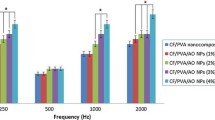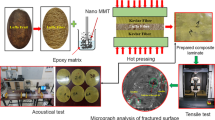Abstract
Excessive noises frequently disturb people by fatigue, reduced working efficiency and health system disorders. An efficient method to reduce noise is to find and apply sound insulation materials. Research and development on nanocomposites as a sound insulation material are quite advanced. In this study, acrylonitrile–butadiene–styrene (ABS)/nanoclay nanocomposites were fabricated at 2, 4, 6 and 8 wt% of organically modified clay using a twin screw extruder. Sound transmission loss (STL) was determined by impedance tube device to evaluate the sound insulation properties of the samples. The results showed that ABS/clay (4 wt%) and (8 wt%) could improve the STL of virgin ABS by 6–20 and 4–5 dB at high (1600–6300 Hz) and low (700–1600 Hz) frequency ranges, respectively. In addition, the physical and mechanical characteristics of the nanocomposites were evaluated at various filler loadings to compare with sound insulation efficiency. Modulus of elasticity was improved in presence of nanoclay in accordance with increasing STL at low sound frequency. The surface density of samples varied slightly with increases in nanoclay content; therefore, it could not be a leading parameter to influence STL at all frequencies. State of dispersion in nanocomposites was investigated using X-ray diffraction and transmission electron microscopy. It was found that a sample containing 4 wt% of nanoclay showed the best dispersion accompanied by the best soundproofing efficiency.







Similar content being viewed by others
References
Krishnamurti S (2009) Sensorineural hearing loss associated with occupational noise exposure: effects of age-corrections. Int J Environ Res Public Health 6:889–899
Nandi SS, Dhatrak SV (2008) Occupational noise-induced hearing loss in India. Indian J Occup Environ Med 12:53–56
Nelson DI, Nelson RY, Concha-Barrientos M, Fingerhut M (2005) The global burden of occupational noise-induced hearing loss. Am J Ind Med 48:446–458
Kim BJ (2012) The effect of inorganic fillers on the properties of wood plastic composites, (thesis). The school of renewable natural resources, Louisiana
Ng CF, Hui CK (2008) Low frequency sound insulation using stiffness control with honeycomb panels. Appl Acoust 69:293–301
Liang JZ, jiang XH (2012) Soundproofing effect of polypropylene/inorganic particle composites. Compos Part B 43:1995–1998
Allan PS, Ahmadnia A, Withnall R, Silver J (2013) Sound transmission testing of polymer compounds. Polym Test 31:312–321
Wikibooks contributors (2005) Engineering acoustics. Wikibooks. http://en.wikibooks.org/wiki/Engineering_Acoustics/Filter_Design_and_Implementation
Yun J, Kim MS, Kang KM, Joo KH, Kang YJ, Ahn SH (2014) Evaluation of PP/Clay composites as soundproofing material. Polym Polym Compos 22:65–72
Lee J, Kim GH, Ha CS (2012) Sound absorption properties of polyurethane/nano-silica nanocomposite foams. J Appl Polym Sci 123:2384–2390
Zhao J, Wang XM, Chang JM, Yao Y, Cui Q (2010) Sound insulation property of wood-waste tire rubber composites. Compos Sci Technol 70:2033–2038
Kim MS, Yun J, Kang MN, Joo KH, Pandey JK, Kang YJ, Ahn SH (2013) Soundproofing properties of polypropylene/clay/carbon nano tube nanocomposites. J Appl Polym Sci 130:504–509
Kord M, Tajik B (2014) Effect of organomodified montmorillonite on acoustic properties of wood-plastic nanocomposites. J Thermoplast Compos 27(6):741–757
Mirzaei Aliabadi M, Naderi GH, Shahtaheri SJ, Rahimi Forushani A, Mohammadfam I, Jahangiri M (2014) Transport properties of carboxylated nitrilebutadiene rubber (XNBR)-nanoclay composites; a promising material for protective gloves in occupational exposures. J Environ Health Sci Eng 12:1–8
Lee JC, Hong YS, Nan RG, Jang MK, Lee CS, Ahn SH, Kang YJ (2008) Soundproofing effect of nano particle reinforced polymer composites. J Mech Sci Technol 22:1468–1474
Cosoli P, Scocchi G, Pricl S, Fermeglia M (2008) Many-scale molecular simulation for ABS–MMT nanocomposites: upgrading of industrial scraps. Micropor Mesopor Mat 107:169–179
Salimi A, Subasi M, Buldu L, Karatas C (2013) Prediction of flow length in injection molding for engineering plastics by fuzzy logic under different processing conditions. Iran Polym J 22:33–41
Liang JZ, Jiang XH (2012) Sound insulation in polymer/inorganic particle composites.I. theoretical model. J Appl Polym Sci 125:676–681
BSWA Technology (1998) Chaina impedance tube solutions booklet, Beijing. http://www.bswa-tech.com. Accessed 21 April 2014
ASTM E2611-09 (2009) Standard test method for measurement of normal incidence sound transmission of acoustical materials based on the transfer matrix method
Kim MS, Yan J, Kang KM, Joo KH, Kang YJ, Ahn SH (2013) Soundproofing ability and mechanical properties of polypropylene/exfoliated graphite nanoplatelet/carbon nanotube (PP/xGnP/CNT) composite. Int J Precis Eng Manuf 14:1087–1092
Sung CH, Lee KS, Lee KSE, Min SO, Kim JH, Kim MS, Jeong HM (2007) Sound damping of a polyurethane foam nanocomposite. Macromol Res 15(5):443–448
Mirzaei Aliabadi M, Naderi GH, Shahtaheri SJ, Rahimi Forushani A, Mohammadfam I, Jahangiri M (2014) Mechanical and barrier properties of XNBR-clay nanocomposite: a promising material for protective gloves. Iran Polym J 23:289–296
Wang X, You F, Zhang FS, Li J, Guo S (2011) Experimental and theoretic studies on sound transmission loss of laminated mica-filled poly(vinyl chloride) composites. J Appl Polym Sci 122:1427–1433
Mortazavi S, Ghasemi I, Oromiehie A (2013) Prediction of tensile modulus of nanocomposites based on polymeric blends. Iran Polym J 22:437–445
Lee JW, Lee JC, Pandey J, Ahn SH, Kang YJ (2010) Mechanical properties and sound insulation effect of ABS/carbon-black composites. J Compos Mater 44(14):1701–1716
Yousefi N, Grammarian I, Bagheri R, Zokaei S (2010) Role of elastic modulus on the acoustic transmission loss of polypropylene/barium sulfate/calcium carbonate nanocomposites with microfiller/nanofiller bimodal size distribution. Paper presented at the proceedings of the 3rd conference on nanostructures, Kish Island, I. R. Iran
Acknowledgments
This research has been funded by Tehran University of Medical Sciences and Health Services Grant (Project No. 92-02-27-23551). Moreover, the supports received by Iran Polymer and Petrochemical Institute are highly appreciated.
Author information
Authors and Affiliations
Corresponding author
Rights and permissions
About this article
Cite this article
Ahmadi, S., Nassiri, P., Ghasemi, I. et al. Sound transmission loss through nanoclay-reinforced polymers. Iran Polym J 24, 641–649 (2015). https://doi.org/10.1007/s13726-015-0353-0
Received:
Accepted:
Published:
Issue Date:
DOI: https://doi.org/10.1007/s13726-015-0353-0




